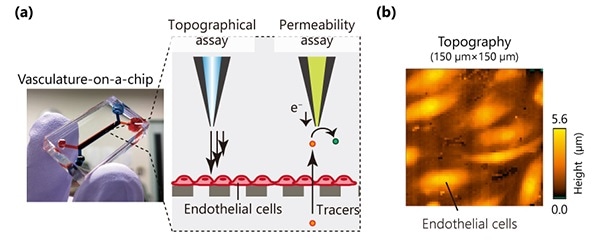A microphysiological system (MPS), also called an organ-on-a-chip, is a 3D organ construct employing human cells that help unravel the response of organs to drugs and environmental stimuli.

Endothelial functions (permeability and topography) in a microphysiological system (MPS) are electrochemically visualized using scanning probe microscopies (SPMs). The analytical system is a new means to evaluate MPS or organ-on-a-chip (OoC). Image Credit: Yuji Nashimoto.
Recently, scientists from Tohoku University created a novel analytical technique that visualizes cell functions in MPS using scanning probe microscopy (SPM).
SPM differs from optical microscopy as it uses fine probe scanning over a sample surface and later exploits the local interactions between the probe and the surface. The greatest advantage of SPM over traditional microscopy is that chemical and physical conditions can be obtained quickly and as a high-resolution image.
In the current research, SPMs estimated a vascular model (vasculature-on-a-chip) by scanning electrochemical microscopy (SECM) and scanning ion conductance microscopy (SICM). Employing these SPMs, the scientists quantified the permeability and topographical data of the vasculature-on-a-chip.
MPS shows potential to recapitulate the physiology and functions of their counterparts in the human body. Most research on this topic has focused on the construction of biomimetic organ models. Today, there is an increasing interest in developing sensing systems for MPS.”
Yuji Nashimoto, Study First Author, Frontier Research Institute for Interdisciplinary Sciences, Tohoku University
In some cases, electrochemical sensors are used to monitor MPS. But a majority of the electrochemical sensors cannot procure the spatial information of cell functions in MPS as they contain only one sensor per analyte. On the contrary, SPM offers spatial information about cell functions quickly.
Our research group has developed various electrochemical imaging tools, SPMs, and electrochemical arrays. These devices will help usher in next-generation sensors in MPS.”
Hitoshi Shiku, Study Corresponding Author, Tohoku University
Source:
Journal reference:
Nashimoto, Y., et al. (2021) Topography and Permeability Analyses of Vasculature-on-a-Chip Using Scanning Probe Microscopies. Advanced Healthcare Materials. doi.org/10.1002/adhm.202101186.